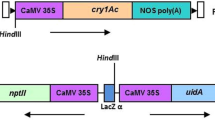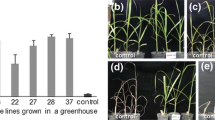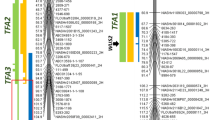Abstract
A population of 42 transgenic sugarcane ( hybrid, cv. Ja60‐5) clones expressing a truncated cryIA(b) gene from Bacillus thuringiensis was evaluated in field trials under artificial borer (Diatraea saccharalis Fab.) infection. Five clones displaying the highest borer tolerance were selected and analysed with molecular tools (RAPD, AFLP and RAMP) to verify genomic changes. Results of field trials provided evidence both for the expression of the resistance trait and for the occurrence of limited but consistent morphological, physiological and phytopathological variation, as compared with control plants regenerated from dedifferentiated culture without transformation (C1‐control) or with plants that were clonally propagated in the field (C2‐control). The five elite transgenic clones, selected for consistent borer‐resistance and good agronomic traits, were further evaluated in a large scale field trial. It was found that the majority of agronomic and industrial traits were those of the original cv. Ja60‐5, but that a small number of qualitative traits was different. DNA changes were verified in the five selected clones. A total of 51 polymorphic DNA bands (out of the 1237 analysed bands) was identified by extensive AFLP and RAMP analysis, thus showing rare but consistent genomic changes in the transgenic plants, as compared with C1‐ and C2‐control plants. It is proposed that the increased variability verified in transgenic plants by field trials and DNA analysis is essentially correlated with cell growth in the dedifferentiated state during the transformation procedure. The results, which are consistent with those published in the case of other transgenic plant populations, are discussed in the context of selecting approaches to gene transfer that minimize somaclonal variation. This is important especially in cases, such as that of sugarcane, where success of backcrosses to restore the original genotype is made difficult by the complex ploidy state of the plant.
Similar content being viewed by others
References
Adang M, Brody M, Cardineau G, Eagan N, Roush R, Shewmaker C, Jones J, Oakes J and McBride K (1993) The reconstruction and expression of a Bacillus thuringiensis cryIIIA gene in protoplasts and potato plants. Plant Mol Biol 21: 1131–1145.
Arencibia A, Molina P, Gutierrez C, Fuentes A, Greenidge V, Menendez E, De la Riva G and Selman-Housein G (1992) Regeneration of transgenic sugarcane (Saccharum officinarum L.) plants from intact meristematic tissue transformed by electroporation. Biotecnologia Aplicada 9: 156–165.
Arencibia A, Molina P, De la Riva G and Selman-Housein G (1995) Production of transgenic sugarcane (Saccharum officinarum L.) plants by intact cell electroporation. Plant Cell Rep 14: 305–309.
Arencibia A, Vasquez R, Prieto D, Tellez P, Carmona E, Coego A, Hernandez L, De la Riva G and Selman G (1997) Transgenic sugarcane plants resistant to stem borer attack. Mol Breed 3: 247–255.
Arencibia A, Gentinetta E, Cuzzoni E, Castiglione S, Kohli A, Vain P, Leech M, Christou P and Sala F (1998a) Molecular analysis of the genome of transgenic rice (Oryza sativa L.) plants produced via particle bombardment or intact cell electroporation. Mol Breed 4: 99–109.
Arencibia A, Carmona E, Tellez P, Chan MT, Yu SM, Trujillo L and Oramas P (1998b) An efficient protocol for sugarcane (Saccharum spp.) transformation mediated by Agrobacterium tumefaciens. Transgenic Res 7: 213–222.
Bao P, Granata S, Castiglione S, Wang G, Giordani C, Cuzzoni E, Damiani G, Bandi C, Datta S, Datta K, Potrykus I, Callegarin A and Sala F (1996) Evidence for genomic changes in transgenic rice (Oryza sativa L.) recovered from protoplasts. Transgenic Res 5: 97–103.
Bellini C, Giordani C, Lupotto E, Locatelli F, Cuzzoni E, Avogadro E, Castiglione S and Sala F (1992) Stability of a foreign gene in transgenic Nicotiana tabacum L. plants during a cycle of dedifferentiation/differentiation. Plant Sci 82: 193–200.
Blundy KS, Blundy MA, Carter D, Wilson F, Park WD and Burrell MM (1991) The expression of class I patatin gene fusions in transgenic potato varies with both gene and cultivars. Plant Mol Biol 16: 153–160.
Castiglione S, Wang G, Damiani G, Bandi C, Bisoffi S and Sala F (1993) RAPD fingerprints for the identification of elite poplar (Populus spp.) clones. Theor Appl Genet 85: 54–59.
Christou P, SwainWF, Yang NS and McCabe DE (1989) Inheritance and expression of foreign genes in transgenic soybean plants. Proc Natl Acad Sci USA 86: 7500–7504.
De la Riva G and Adang M (1996) Expression of Bacillus thuringiensis _-endotoxin genes in transgenic plants. Biotecnologia Aplicada 13: 251–260.
Dellaporta L, Wood J and Hicks J (1983) A plant minipreparation. Version II. Plant Mol Biol Rep 1: 19–21.
D'Halluin K, Bonne E, Bossut M, De Beuckeleer M and Leemans J (1992) Transgenic maize plants by tissue electroporation. The Plant Cell 4: 1495–1505.
D'Hont A, Grivet L, Feldmann P, Rao S, Berding N and Glaszmann J (1996) Characterization of the double genome structure of modern sugarcane cultivars (Saccharum spp.) by molecular cytogenetics. Mol Gen Genet 250: 405–413.
Evans DA and Sharp WR (1986) Applications of somaclonal variations. Bio/Tech 4: 528–532.
Gilissen L, Metz P, Stiekema W and Nap J (1998) Biosafety of E. coli _-glucuronidase (GUS) in plants. Transgenic Res 7, 157–163.
Grivet L, D'Hont A, Roques D, Feldmann P, Lanaud C, Glaszmann J (1996) RFLP mapping in cultivated sugarcane (Saccharum spp.): genome organization in a highly polyploid and aneuploid interspecific hybrid. Genetics 142: 987–1000.
Heine DJ, Mee GW and Nickell LG (1969) Chromosome number of some Saccharum species hybrids and their cell suspension cultures. Am J Bot 56: 450–456.
Heinz DJ and Mee GW (1970) Morphologic cytogenetic and enzymatic variation in Saccharum species hybrid clones derived from callus tissue. Am J Bot 58: 257–262.
Heinz D, Krishnamurti M, Nickel L and Maretski A (1977) Cell tissue and organ culture in sugarcane improvement. In: Reinert and Bajab (eds.) Applied and Fundamental Aspects of Plant Cell Tissue and Organ Cultures, (pp. 3–17) Springer-Verlag, New York.
Hobbs SL, Warkentin TD and DeLong CM (1993) Transgene copy number can be positively or negatively associated with transgene expression. Plant Mol Biol 21: 17–26.
INICA. (1987) In: Minaz (ed.) Methodology for sugarcane genetic improvement: germplasm evaluation and breeding programmes, National Institute for Sugarcane Research, Ciudad Habana, Cuba.
Jørgensen R (1990) Altered gene expression in plants due to transinteraction between homologous genes. Trends Biotech 8: 340–344.
Karp A (1991) On the current understanding of somaclonal variation. Oxford Surveys. Plant Mol Cell Biol 7: 1–58. (1998) In: Karp A, Isaac P, Ingram D (eds.) Molecular tools for screening biodiversity, Chapman & Hall, London.
Klöti A, Iglesias V, Wünn J, Burkhardt P, Datta S and Potrykus I (1993) Gene transfer by electroporation into intact scutellum cells of wheat embryos. Plant Cell Rep 12: 671–675.
Koziel M, Beland G, Bowman C, Carrozi N, Crenshaw R, Crossland L, Dawson J, Desai N, Hill M, Kadwell S, Launis K, Lewis K, Maddox D, McPherson K, Meghji M, Merlin E, Rhodes R, Warren G, Wright M and Evola S (1993) Field performance of elite transgenic maize plants expressing an insecticidal protein derived from Bacillus thuringiensis. Bio/Tech 11: 194–200.
Larkin P and Scowcroft W (1981) Somaclonal variation: a novel source of variability from cell cultures for plant improvement. Theor Appl Genet 60: 197–214.
Larkin P and ScowcroftW(1983) Somaclonal variation and eyespot toxin tolerance in sugarcane. Plant Cell Tiss Org Cult 2: 111–121.
Lörz H and ScowcroftWR (1983) Variability among plants and their progenies regenerated from protoplasts of Su/su heterozygotes of Nicotiana tabacum Theor Appl Genet 66: 67–75.
McCowen BH, McCabe DE, Russell DR, Robinson DJ, Barton KA and Raffa KF (1991) Stable transformation of Populus and incorporation of pest resistance by electric discharge particle acceleration. Plant Cell Rep 9: 590–594.
Perlak F, Deaton R, Armstrong T, Fuch R, Sims S, Greenplate J and Fischhoff D (1990) Insect resistant cotton plants. Bio/Tech 8: 939–943.
Pescitelli S and Shukhapinda K (1995) Stable transformation via electroporation into maize Type II callus and regeneration of fertile transgenic plants. Plant Cell Rep 14: 712–716.
RamosM, Maribona R, Pèrez A, Korneva S, Canales E and Dinkovà T (1996) Somaclonal variation as a source of eyespot disease resistance in sugarcane. Plant Breed 115: 37–43.
Register JC, Peterson DJ, Bell PJ, Bullock WP, Evans IJ, Frame B, Greenland AJ, Higgs NS, Jepson I, Jiao S, Lewnau CJ, Sillick JF and Wilson HM (1994) Structure and function of selectable and non-selectable transgenes in maize after introduction by particle bombardment. Plant Mol Biol 25: 951–961.
Robinson DJ, McCowen BH, Raffa KF (1994) Response to gypsy moth (Lepidoptera: Lymantridae) and forest tent carterpillar (Lepidoptera: Lasiocampidae) to transgenic poplar, Populus spp., containing a Bacillus thuringienisis _-endotoxin gene. Environ Entomol 23: 1030–1041.
Rogers HJ and Parkers HC (1995) Transgenic plants and the environment. J Exp Bot 46: 467–488.
Sambrook J, Fritsch EF and Maniatis T (1989) Molecular cloning: a laboratory manual, 2nd edition Cold Spring Harbor Laboratory Press, N.Y.
Senior ML and Heun M (1993) Mapping maize microsatellites and polymerase chain reaction confirmation of the target repeats using a CT primer. Genome 36: 884–889.
Skirvin RM and Janick J (1976) Tissue culture-induced variation in scented Pelargonium spp. J Amer Soc Hort Sci 101: 281–290.
Sneath PHA and Sokal RR (1973) In: Freman WH (ed.) Numerical taxonomy: the principles and practice of numerical classification. San Francisco, USA.
Spencer LS and Meade GP (1963) Sugarcane handbook, 9th edition. Wiley, New York.
Vos P, Hogers R, Bleeker M, Reijans M, van de Lee T, Hornes M, Frijters A, Pot J, Peleman J, Kuiper M and Zabeau M (1995) AFLP: A new technique for DNA fingerprinting. Nucleic Acids Res 23: 4407–4414.
Wang G, Castiglione S, Chen Y, Li L, Han Y, Yingchuan T, Gabriel D, Yinong H, Mang K and Sala F (1996) Poplar (Populus nigra L.) plants transformed with a Bacillus thruringiensis toxin gene: insecticidal activity and genomic analysis. Transgenic Res 5: 289–301.
Williams J, Kubelik A, Livak K, Rafalski J and Tingey S (1990) DNA polymorphisms amplified by arbitrary primers are useful as genetic markers. Nucl Acids Res 18: 6531–6535.
Wu K and Tankley SD (1983) Abundance, polymorphism and genetic mapping of microsatellites in rice. Mol Gen Genet 241: 225–235.
Wu K, Jones R, Danneberger L and Scolnik P (1994) Detection of microsatellite polymorphisms without cloning. Nucl Acids Res 22: 3257–3258.
Xu X and Li B (1994) Fertile transgenic Indica rice plants obtained by electroporation of the seed embryo cells. Plant Cell Rep 13: 237–242.
Zabeau M and Vos P (1993) Selective restriction fragment amplification: a general method for DNA fingerprinting. European Patent Application, publication no. EP 0534858-A1, No. 92402629.7.
Author information
Authors and Affiliations
Rights and permissions
About this article
Cite this article
Arencibia, A.D., Carmona, E.R., Cornide, M.T. et al. Somaclonal variation in insect‐resistant transgenic sugarcane (Saccharum hybrid) plants produced by cell electroporation. Transgenic Res 8, 349–360 (1999). https://doi.org/10.1023/A:1008900230144
Issue Date:
DOI: https://doi.org/10.1023/A:1008900230144




